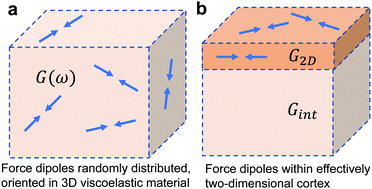Active gels, heavy tails, and the cytoskeleton
Abstract
The eukaryotic cell's cytoskeleton is a prototypical example of an active material: objects embedded within it are driven by molecular motors acting on the cytoskeleton, leading to anomalous diffusive behavior. Experiments tracking the behavior of cell-attached objects have observed anomalous diffusion with a distribution of displacements that is non-Gaussian, with heavy tails. This has been attributed to “cytoquakes” or other spatially extended collective effects. We show, using simulations and analytical theory, that a simple continuum active gel model driven by fluctuating force dipoles naturally creates heavy power-law tails in cytoskeletal displacements. We predict that this power law exponent should depend on the geometry and dimensionality of where force dipoles are distributed through the cell; we find qualitatively different results for force dipoles in a 3D cytoskeleton and a quasi-two-dimensional cortex. We then discuss potential applications of this model both in cells and in synthetic active gels.



 Please wait while we load your content...
Please wait while we load your content...